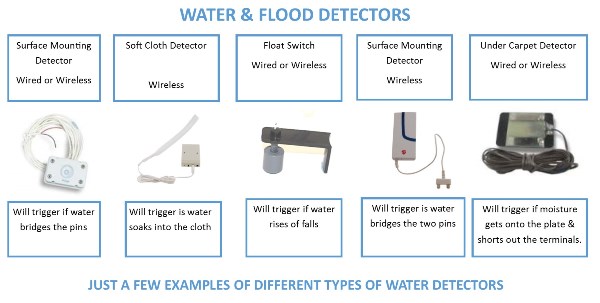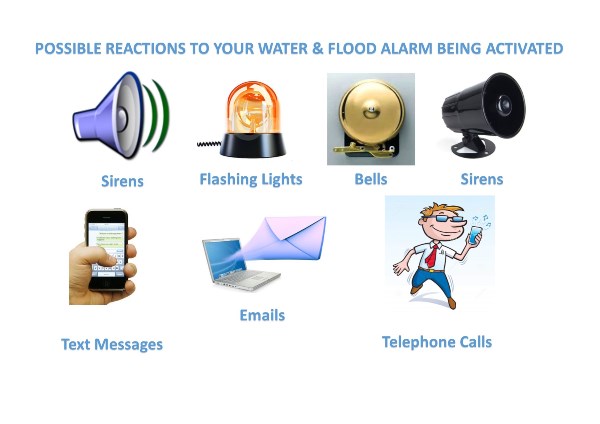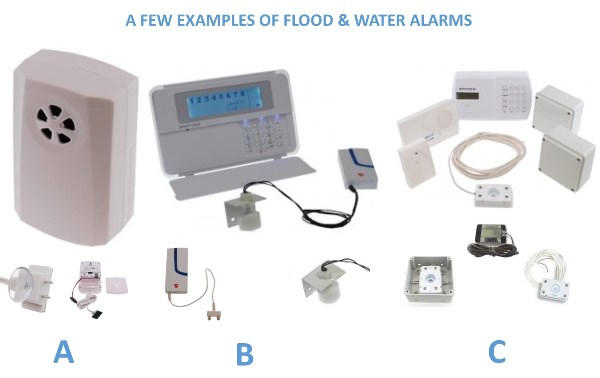How Do I Choose a Water Leakage or Flood Alarm?
Floods are becoming a common factor of life here in the UK and most other parts of the world, and if we listen to most scientists it appears that due to the warming Climate things are only going to get worse.
All Floods no matter how big can and do cause havoc to both Homes, Businesses & Lives.
It is impossible to even contemplate trying to prevent these extreme situations, this needs to be left up the Government’s, Environmental Agencies & Nature, but it is possible to monitor and in some cases prevent flooding from more minor situations such as Water Leaks, Blocked Pipes, Damaged Roofs & Rising Water by using various types of Water Alarms.
Early detection of these potential problems can sometimes save thousands of pounds of damage to buildings, furniture & stock.
Water & Flood Alarms
There are many types of Water Alarms available today, varying in price, practicality & complexity, listed below is a guide to help choosing the most suitable system for your application.
We can split the systems into three categories:
D = Detection.
T = Transmission.
R = Reception.
Detection:
What type of Detector you should choose?
The selection of potential Water Detectors is endless, so taking some time to find one to suit your application will be time well spent.
Where should you place the Detector?
There are many locations that may be suitable for the location of the Water & Flood Detector, these may include:
- Skirting Board: (under a bath, sink, washing machine or down in a cellar, but located in a position most likely to having an early indication of a problem).
- Under a carpet.
- Near a sump pump reservoir.
- Directly on the floor in the corner of a cellar.
- Near a manhole.
- Near to a small stream.
- Overflow pipes.
- Simply in your Garden.
- In a roof space (under a boiler or near to a suspect joint).
- The list is Endless.
If you start by trying to work out where & how a flood may start, you can then decide on what type of Water Sensor is most suitable to use at this location.
When placing the chosen Sensor (or sensors), it is advisable to position them in a location where it is most likely that water would first collect, for example in low ground, at the bottom of an uneven surface, directly under a water connector, the first place a stream will flow over the banks.
If there doesn’t appear to be a natural collecting point for the water, then it is often possible to make one, this probably wouldn’t take top much effort or imagination !!
How many Detectors do you need?
This decision is important for two reasons:
- Obviously to detect water from all possible sources, there is no point in protecting just one area when it is quite possible that water may gather in multiple locations, if there is just one natural collecting point from potential water leaks, then you are lucky and one detector may be enough.
- If you need more than one detector, then it may rule out your preferred water alarm system, therefore it is important that the Water Alarm that can operate with the number of Water Sensors required.
Transmission:
Wired: ( a water detector connected to the control panel by cable, this has the benefits of not having to worry about wireless transmission reliability, but the challenge of having to lay cable safely & neatly which can be a problem).
Wireless: (using a wireless signal from the detectors to the chosen control panel can make the installation far easier & quicker in many situations, sometimes this will be the only practical solution to consider. However we recommend a lot of thought is taken to ensure that the system chosen has adequate transmission capacities, and that all potential obstructions to the wireless signal are taken into account, please click here for more information about wireless transmission & line of sight principles are explained).
Reception:
After making all the effort in choosing the correct type & quantity of Water Sensors, the most important part of the jigsaw is, what do you want to happen in the event of a Water Leak or Flood being detected ?
Options are numerous including:
- Sirens.
- Flashing Lights.
- Bells & Chimes.
- Telephone Calls & Text Messages.
- A Combination of any of the Above.
There are no right or wrong decisions, just a decision to suit your application & lifestyle.
A few Examples of Water & Flood Alarms:
Example A:
This is a stand-alone Water Alarm, with a built in Buzzer & optional Output Relay, the water probe can be used whilst it is still attached to the control panel & the control panel can be simply positioned in the location most prone to any water collecting, or it can be moved a few metres away from the potential water problem by unravelling the coiled cable on the Water Probe. It could also have a emergency auto-dialer connected into the output relay.
Example B:
This system comprises of a Float Switch designed to monitor rising or falling water (depending on which direction it is mounted) or a general water detector, both would be connected to a battery powered wireless transmitter.
The control panel has some impressive features including:
- Built in Telephone Dialer (contacts owners by telephone with your personal recorded message).
- Built in Siren.
- Built in Chime with a Flashing LED.
Example C:
We have long range Wireless Water & Flood Alarms (example here) that can be used with various Sensors and can activate a multitude of accessories including loud Outdoor Bells, Sirens, Buzzers, Flashing Lights together with being able to trigger GSM Auto-Diallers which will contact key-holders by Phone & text.
There are other Flood Alarms now on the market including:
- Battery Powered GSM Flood Alarms (which can be used to monitor remote locations and buildings).
- Wi-fi Water Alarms (which can be connected to your home or works wi-fi networks and will contact you via Push Notifications through Free APPs).
There are many types of systems that are available or can potentially be made for you, click here to see some other options.
Summary:
Choosing a Water or Flood Alarm is never going to prevent a major Flood, but they may give you a vital early warning allowing you to, at best prevent a Flood, at worst give you time to move valuable furniture & stock into a safe location. Ultra Secure Direct carry a wide range of Water & Flood Alarms all designed for easy DIY Installation and would be delighted to give you Honest, No Obligation Advice.
Visit and give us your thoughts on our other Blogs !!
By Mark Walter Google




